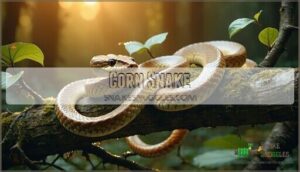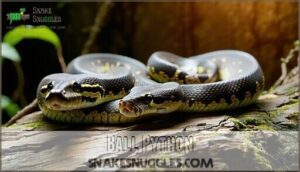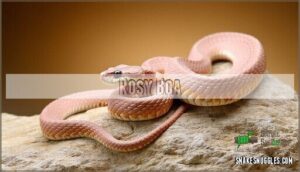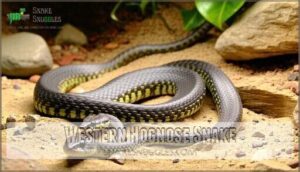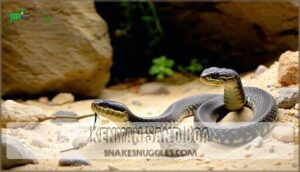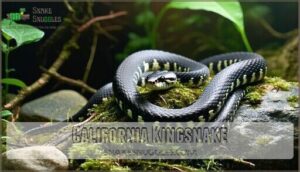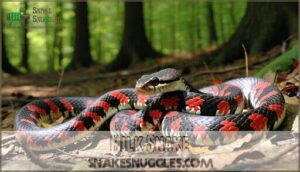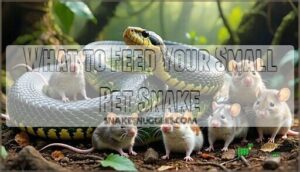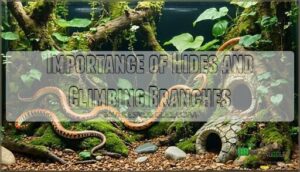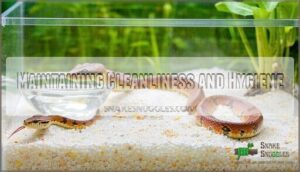This site is supported by our readers. We may earn a commission, at no cost to you, if you purchase through links.
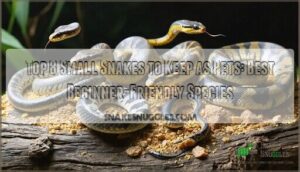
They offer a calm demeanor, modest enclosure needs, and little fuss—perfect for anyone who’d rather avoid a hissy fit at cleaning time. With each, you’ll get a pet that’s as easygoing as an old pair of sneakers, minus the scent.
Stick around for tips on keeping these scaled roommates thriving.
Table Of Contents
- Key Takeaways
- Why Choose a Small Snake as a Pet?
- Essential Care Tips for Small Snakes
- Top 8 Small Snakes for Beginners
- What to Feed Your Small Pet Snake
- Creating The Perfect Snake Habitat
- Frequently Asked Questions (FAQs)
- What are the best terrariums or enclosures for small pet snakes?
- What signs of illness or distress should I watch out for with my pet snake?
- Can pet snakes be litter box trained?
- How often do small snakes shed their skin?
- Can small snakes recognize their owners?
- What veterinary care do small snakes need?
- How long can small snakes go without eating?
- Do small snakes need companions or prefer solitude?
- Conclusion
Key Takeaways
- You’ll get manageable companions – These 8 small snake species (corn snakes, ball pythons, rosy boas, western hognose, Kenyan sand boas, California kingsnakes, milk snakes, and children’s pythons) stay compact and won’t outgrow your space or patience.
- Care requirements are beginner-friendly – You need basic setups with 30+ gallon enclosures, proper heating gradients (85-90°F basking spots), controlled humidity (30-60%), and simple feeding schedules every 1-2 weeks with appropriately-sized rodents.
- They’re naturally calm and safe – Most species have docile temperaments with minimal bite risk, making them ideal for kids and new keepers who want predictable, gentle handling experiences.
- Costs stay low long-term – You’ll save money with hypoallergenic pets that need no grooming, minimal vet visits, affordable housing setups, and inexpensive frozen rodent diets that store easily.
Why Choose a Small Snake as a Pet?
You’ll find that small snakes offer a unique mix of gentle behavior, low maintenance needs, and easy housing requirements, making them ideal for beginners. They’re often so relaxed, you might catch yourself envying their minimalist lifestyle.
Space-Saving and Low Maintenance
Even if you’re tight on space, a small snake fits right in. Minimal enclosures suit rosy boas, Kenyan sand boas, or a corn snake, making upkeep a breeze.
These quiet companions need easy feeding, basic cleaning, and little else. Cost efficiency is high, and you’ll quickly see why they’re so beginner friendly—no complex housing or fussy requirements involved.
Safe and Gentle Temperament
With small pet snakes, gentle temperaments are the star of the show. These beginner-friendly snakes rarely bite and adapt to safe handling techniques. Variations exist, but most docile species pose minimal bite risk, especially for children. Look for these benefits:
- Low bite risk
- Great for kids
- Docile species
- Easy handling techniques
- Predictable snake temperament
Hypoallergenic and Quiet Pets
Breathe easy—small pet snakes are hypoallergenic, making them the allergy superhero in your home. With no fur or dander, you’ll skip the tissues. These silent companions bring Noise Reduction and Dander Absence. No barking or squeaking, just pure quiet handling. Snake ownership requires long-term commitment to guarantee their well-being. If you’re seeking Allergy Benefits and peace, these beginner-friendly snakes are perfect.
| Snake Species | Allergy Trigger | Noise Level |
|---|---|---|
| Corn Snake | None | Silent Companion |
| Ball Python | None | Very Quiet |
| Rosy Boa | None | Whisper-quiet |
| Milk Snake | None | No Noise |
| Kenyan Sand Boa | None | Zero Decibels |
Cost-Effective Care
You’ll find beginner pet snake care surprisingly budget-friendly. Affordable enclosures fit small pet snakes perfectly, and DIY enrichment keeps things interesting. Snake feeding is simple—rodents are cheap and easy to store.
Healthcare costs stay low with proper snake care basics, leading to long-term savings. A well-maintained snake enclosure means less fuss and more freedom to enjoy your new companion.
Essential Care Tips for Small Snakes
You’ll need to pay close attention to your small snake’s enclosure, temperature, and handling routines to keep them healthy. With the right setup, even a shy Rosy Boa or curious Corn Snake can feel right at home—no snake charmer required.
Ideal Enclosure Size and Setup
You’ll want an enclosure that’s at least 30 gallons for most small snakes—think roomy, not cavernous. Focus on proper Enclosure Dimensions, easy-to-clean Substrate Options, and a few Enrichment Items like branches or hides. Snake enclosures should mimic a natural snake habitat.
To guarantee their well-being, consider temperature gradient importance. Remember, good snake care basics and reptile care start with a secure, escape-proof setup.
Heating, Lighting, and Humidity Needs
Inside your snake habitat, getting the temperature gradient just right keeps your pet healthy and active. Don’t forget humidity control, especially for shedding. Lighting schedules mimic natural cycles, helping with seasonal adjustments. A reliable heat source is essential for maintaining proper temperatures.
Here’s a quick checklist:
- Maintain a basking spot (85–90°F).
- Monitor humidity (30–60%).
- Set up day/night lighting schedules for proper reptile care.
Safe Handling Practices
Always use a gentle, proper grip when handling small pet snakes. Support their body and avoid sudden movements to reduce stress. Recognizing signs of discomfort, like hissing or hiding, helps you avoid bites.
Wash your hands before and after snake handling—good hygiene practices matter. Beginner-friendly snakes often have a calm temperament, making safe snake handling much easier for everyone.
Top 8 Small Snakes for Beginners
You’ll find eight small snake species that are perfect for beginners, each with unique traits and manageable care needs. If you’ve ever wondered which snake won’t outgrow your living room or your patience, this list covers the best options for new keepers.
Corn Snake
Corn snakes are the ultimate choice for beginner-friendly snakes. Their gentle temperament traits and vibrant color morphs make them a favorite among small pet snakes. You’ll appreciate their manageable size and easy pet snake care. With simple enclosure enrichment and minimal health issues, corn snakes rarely bite.
Their ideal habitat includes a temperature gradient with a cool side, warm side, and basking spot. Watching their curious breeding habits is like seeing nature’s puzzle unfold, minus any drama.
Ball Python
Curiosity meets calm with the Ball Python, a champion among beginner-friendly snakes. You’ll love their docile temperament and wild morph variations.
When caring for these small pet snakes, remember:
- Enclosure size: at least 40 gallons
- Humidity needs: 50–60%
- Feeding habits: rodents every 1–2 weeks
- Temperament issues: rare, mostly defensive
- Pet snake care: simple, rewarding
Rosy Boa
Rosy boas are a top pick for beginner pet snake enthusiasts. Their gentle temperament variations and slow movements mean you’ll rarely get a nip. With striking color morphs and low handling frequency needs, they’re easy to care for.
A secure, enriched enclosure helps them thrive. Their conservation status is stable, making rosy boas a responsible small snake choice for any pet snake species lover.
It’s important to understand their specific care requirements before bringing one home.
Western Hognose Snake
If you’re drawn to quirky small snakes, the Western Hognose Snake is a top pick for beginners. Their upturned snout isn’t just for show—it’s perfect for burrowing. You’ll love their docile temperament and dramatic bluffing.
Keep females in a 40-gallon enclosure, and follow the enclosure size guidelines to guarantee the snake has enough space. Feeding habits are simple—rodents work best.
Plus, their color morphs add visual flair to any Pet Snakes collection.
Kenyan Sand Boa
The Kenyan Sand Boa is a burrowing champion among pet snakes. You’ll love its morph variations and compact pet snake sizes. With a proper temperature gradient and enclosure enrichment, this beginner friendly snake thrives. Watch for shedding issues, but overall, it’s a hardy snake species. Here’s why they’re great:
- Docile temperament
- Unique burrowing behavior
- Minimal space needs
- Easy care
California Kingsnake
California King Snake stands out among pet snake breeds for its striking pattern variations and manageable size. You’ll appreciate their temperament handling, especially with captive breeding making them calm companions.
In their natural habitat, kingsnakes adapt well, but in captivity, they thrive with a secure setup. Watch out for common illnesses like respiratory infections—regular cleaning and proper humidity keep your California Kingsnake healthy.
Milk Snake
If you’re eyeing Pet Snakes that stand out, Milk Snakes offer a colorful twist after the California Kingsnake. This Snake Species boasts striking Color Morphs and Regional Variations that catch the eye.
You’ll appreciate:
- Manageable size and docile temperament—issues rarely arise
- Conservation status is stable
- Thrives with Captive Breeding
- Secure habits
- Easy care routines
Children’s Python
Milk snakes offer color, but Children’s Pythons bring reliability to pet snakes. These beginner-friendly snakes rarely top four feet, so a roomy enclosure size gives plenty of wiggle room. Enjoy handling ease thanks to their gentle snake temperament.
Their unique markings catch sunlight just right. Feeding habits are simple—once every week or two. A steady choice among pet snake species.
What to Feed Your Small Pet Snake
You’ll need to feed your small pet snake a diet that matches its species, age, and size, whether it’s a corn snake or a ball python. Feeding time is simple once you know what each snake prefers—just be sure to handle their food safely and watch for healthy eating habits.
Recommended Diet by Species
Ever wondered what’s on the menu for your small pet snake? Prey size matters—match it to your snake’s girth. Rosy Boas and Corn Snakes thrive on mice, while Western Hognose and Kenyan Sand Boa may enjoy dietary variety.
Opt for frozen vs live rodents to reduce risks during snake feeding. **Supplementation needs depend on the species and prey type.
Feeding Frequency and Portion Size
Now that you know what to feed your pet snake, let’s talk about how often and how much. Adjust your feeding schedule based on snake age—young Corn Snakes, Milk Snakes, and King Snakes eat every 5–7 days, adults every 10–14 days.
Prey size should match the widest part of your snake to avoid obesity risks and encourage healthy snake feeding.
Safe Food Handling Tips
After figuring out how often and how much to feed, let’s talk snake safety tips. Always use safe sourcing for prey and keep rodent storage separate from your own food. Prey thawing should happen in a sealed bag, not on the counter.
Good hygiene practices—wash hands, clean surfaces—help with parasite prevention. Frozenthenthawed meals keep your pet snake’s habitat and diet healthy.
Creating The Perfect Snake Habitat
You’ll want to set up a habitat that matches your snake’s natural environment, using the right substrate, hides, and climbing branches. If you get the details right, your snake will be happier than a ball python in a fresh hide.
Choosing Substrate and Decor
After picking your snake’s meals, nail their habitat too. Choose substrate types that hold moisture but don’t cause skin trouble—like aspen or coconut fiber—for Humidity control. Keep Decor safety in mind: skip sharp edges or things they can get stuck in. Add enrichment ideas like fake plants or stone hides. Stick to cleaning protocols to keep Snake Enclosures healthy.
Selecting appropriate substrate is essential, and species specific needs should always be considered.
Importance of Hides and Climbing Branches
After choosing the right substrate and decor, think about where your pet snake will unwind. Secure Hiding spots—like caves or cork bark—help pet reptiles feel safe, lowering stress in snake enclosures. Branch Placement isn’t just décor; climbing benefits your snake’s health and mimics natural behavior.
Consider various cave designs to improve your reptile’s comfort. Mix Hide Materials for real enrichment value in a well-rounded snake habitat and diet routine.
Maintaining Cleanliness and Hygiene
Keeping your snake’s habitat clean is a science-backed way to dodge common problems like mites or bad sheds. Focus on regular Enclosure Sanitation, swap out the Water Bowl daily, and scoop waste fast. Little details in handling and feeding routines matter, too—clean hands and tools help keep both you and your pet reptiles healthy.
- Spot-clean waste quickly
- Disinfect water bowls often
- Watch for signs of mites
Frequently Asked Questions (FAQs)
What are the best terrariums or enclosures for small pet snakes?
Much like a skilled mapmaker plans every detail, you’ll want a secure glass terrarium—at least 20–30 gallons—with a tight lid, heating pad, hiding box, and water bowl, so your tiny explorer can thrive.
What signs of illness or distress should I watch out for with my pet snake?
Watch for these warning signs: lethargy, loss of appetite, difficulty shedding, respiratory infections (mouth breathing, wheezing), mites, unusual discharge, and dramatic behavioral changes that persist beyond normal feeding cycles.
Can pet snakes be litter box trained?
Unlike cats or dogs, you can’t litter train pet snakes—they lack the cognitive ability and bladder control for such training. Snakes eliminate waste irregularly, usually after feeding cycles, making scheduled bathroom habits impossible for these reptilian companions.
How often do small snakes shed their skin?
Small snakes shed their skin every 4-8 weeks, with younger snakes shedding more frequently than adults. You’ll notice their eyes turning milky blue before shedding begins, signaling it’s time.
Can small snakes recognize their owners?
Studies show that snakes have limited vision beyond 10-12 inches, making visual owner recognition unlikely. However, you’ll find they can distinguish your scent and learn your handling patterns over time.
What veterinary care do small snakes need?
You’ll need annual veterinary checkups, fecal parasite testing, and emergency care for injuries or illness. Find an exotic veterinarian experienced with reptiles before getting your snake.
How long can small snakes go without eating?
Your slithery friends can usually "fast" for 1-4 weeks, depending on species, age, and health. **Young snakes need food more frequently than adults.
**
Ball pythons famously refuse meals for months without harm, while smaller species like corn snakes require more regular feeding schedules.
Do small snakes need companions or prefer solitude?
Most snake species are solitary creatures that thrive alone. You shouldn’t house multiple snakes together since they’ll compete for resources, potentially fight, and experience unnecessary stress.
Conclusion
Before the printing press transformed communication, snake keepers relied on word-of-mouth wisdom passed down through generations. Today, you’ve got access to proven care guidelines for these top 8 small snakes to keep as pets.
Each species offers unique rewards while maintaining beginner-friendly requirements. Whether you choose a corn snake’s docile nature or a ball python’s stunning patterns, you’re selecting a companion that’ll provide years of fascination with minimal fuss and maximum charm.
- https://paradepets.com/pet-news/best-small-animal-breeds-for-first-time-pet-owners-according-to-a-vet
- https://www.thesprucepets.com/snake-species-1239472
- https://thearenagroup.net/terms-of-use/
- https://www.floridamuseum.ufl.edu/florida-snake-id/snake/brahminy-blindsnake/
- https://nationalzoo.si.edu/animals/corn-snake


